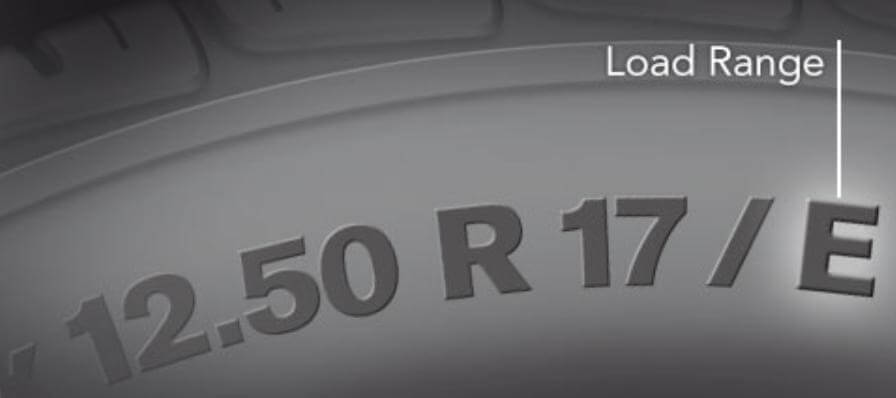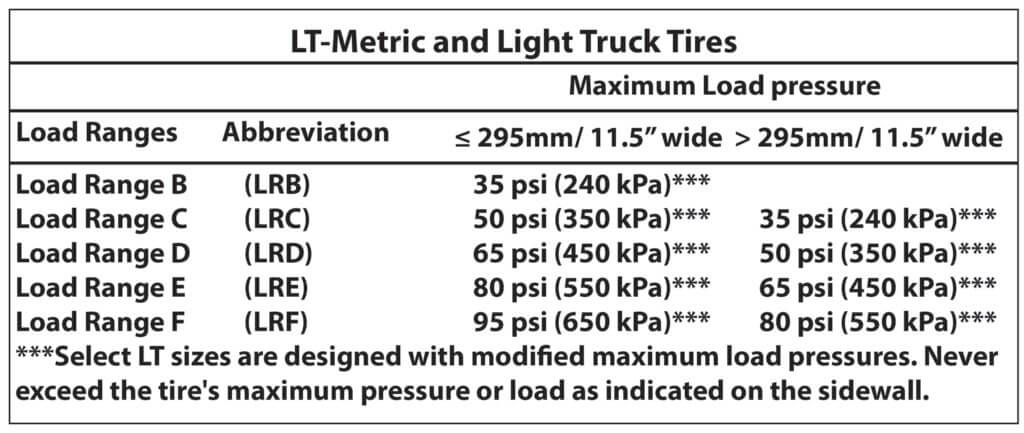Tire pressure and load range
What’s the correct tire pressure based on load range?
The recommended tire pressure and load range for your car is listed on a placard in the driver’s door area. But that recommended pressure is for the tires that came on the car. If you change to a different size tire that’s the same load range, you still use the recommended pressure that’s shown on the placard. But if you change to a different load range tire, follow the charts below.
How to find the tire’s load range
Find the tire’s load range listed as a letter after the tire size markings on the tire sidewall.

Passenger tire load range designations and pressures
Passenger tire load ranges for tires on a sedan, coupe, crossover, or minivan usually aren’t marked because most are made with a standard 4-ply rating and are not designed to carry higher loads.
However, if the passenger tire’s load rating is marked, it’ll be either SL for Standard Load or XL, or Reinforced for Extra Load. The maximum pressure for an SL tire with the vehicle loaded to maximum payload is 36-psi, while the maximum pressure for an XL tire with the vehicle loaded to maximum payload is 42-psi.


When P-metric tires are used on passenger cars they can carry 100% of the load indicated on the tire’s sidewall. However, if you install P-metric passenger tires on a light truck or SUV, you must reduce the tire’s load-carrying capacity to 91% of the load range indicated on the tire’s sidewall. If your truck will exceed that weight limit, you must choose a proportionately larger tire to offset the truck’s higher center of gravity and the possibility that the truck may be overloaded

More about load range and maximum pressure
If you load your vehicle to the maximum payload, you should inflate your tires to the maximum pressure listed in the charts above. For example, if the maximum load rating for a P235/75R15 SL rated tire is 2028-lbs, you should inflate the tire to the maximum 35-psi. If you inflate to a lower pressure you must adjust the maximum load proportionally (example: at 32-psi. the maximum load must be reduced to 1940-lbs and 1852-lbs at 28-psi.)
Maximum load pressure is NOT the same as the tire’s maximum inflation pressure shown on the sidewall
The maximum inflation pressure shown on the tire’s sidewall is usually between 44 and 51-psi for passenger tires. This maximum inflation pressure has nothing to do with the structural integrity of the tire. It will not explode if you inflate to 1-psi over the listed maximum. But inflating to the maximum inflation pressure will impact other aspects of the vehicle.
Inflating to the maximum inflation pressure reduces the size of the contact patch (the portion of the tire tread that’s in contact with the road) significantly. That will reduce ride quality, passenger comfort, and the wear characteristics of a tire.
Over inflating a tire for better fuel economy
Inflating a tire beyond the car maker’s recommendations will provide a slight improvement in fuel economy because the added pressure reduces rolling resistance. HOWEVER, there’s no free lunch here. Since overinflation reduces the tire’s contact patch area, you decrease traction, increase the likelihood of hydroplaning, and cause rapid tire wear and accelerated suspension wear in addition to decreasing ride comfort.
What you save in fuel, you will more than makeup for in reduced tire life and increased repairs to suspension components.
Posted on by Rick Muscoplat